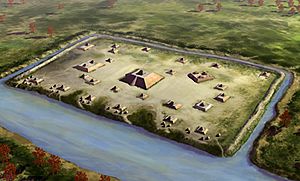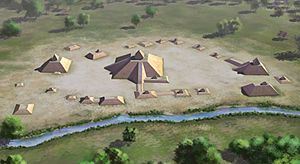Quigualtam facts for kids
Quigualtam or Quilgualtanqui was a powerful Native American Plaquemine culture polity encountered in 1542–1543 by the Hernando de Soto expedition. The capital of the polity and its chieftain also bore the same name; although neither the chief nor his settlements were ever visited in person by the expedition. Their encounters consisted of messages sent by runners and a three-day long canoe battle on the Mississippi River. Multiple archaeological cultures, archaeological sites, and protohistoric and early historic period Native American groups have been proposed by historians and archaeologists to identify the polity, but their identity will probably never be known with any degree of certainty.
Proposed identifications
Various scholars have proposed and debated the identities of Quigualtam and the unnamed chiefdom and the exact locations of their polities. Historian Charles M. Hudson has suggested that Quigualtam was centered on the area surrounding the Holly Bluff or Winterville sites in the lower Yazoo Basin. Archeologists believe that these two large Plaquemine culture sites had been abandoned by this time; the capital of the polity had probably shifted to another of the numerous sites within its territory.
Other scholars have proposed the Glass site and Emerald Mound as possibilities for the two polities. The Glass site is on the flood plain between the Mississippi River and the Natchez Bluffs, approximately 9.5 kilometres (5.9 mi) south of modern Vicksburg. It was on the northern edge of the Emerald Phase (1500–1680) of the protohistoric Natchez chiefdom. During this period, its capital was located at the massive Emerald Mound near modern-day Stanton, Mississippi. These two sites were the only major ceremonial centers on this stretch of the Mississippi River occupied during the protohistoric period from 1500 to 1650 CE. Since the Spaniards never made it ashore to leave archaeological evidence of contact with these two groups, their exact identity will probably never be determined with certainty.
No further recorded European contact with the indigenous people in this area occurred for almost 140 years, until the first French explorers reached the area in the 1680s. By the historic period, power had shifted within the Natchez polity from Emerald Mound to the Grand Village of the Natchez, and the Glass site had also been abandoned.
In the meantime native peoples of the region suffered from epidemics of infectious disease. They contracted these from members of the de Soto expedition, among whom the diseases were endemic, and indirectly from other Native Americans who had contact with European traders on the Gulf coast. The Spaniards' technique of using local rivalries to their advantage had upset the delicate political balance between native groups, who had existed in a state of low-level endemic warfare between polities for generations. In addition, a series of disastrous multi-year droughts spanned the latter half of the 16th century.
Many societies in the region began to collapse. Remnant populations of Mississippian peoples began migrating across and down the Mississippi, sometimes settling in areas recently deserted by Plaquemine peoples, and at other times displacing or merging with the Plaquemine populations on the lower river. The Plaquemine culture contracted southward and abandoned the northern Natchez Bluffs altogether. The Lower Yazoo basin region, once occupied by the Winterville and Holly Bluff polity, became the territory of the historic period Yazoo, Tunica and Koroa tribes. They had migrated from further upriver, thought by archaeologists to be the descendants of Quizquiz and other polities encountered by de Soto in the Memphis area, who were escaping the destruction of their societies left in de Soto's wake. The Tioux and Grigra divisions of the Natchez were recent additions, also Tunica speakers from up the river who had been adopted into the Natchez tribe.



